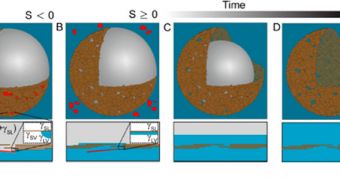In a recent study, investigators made a potentially groundbreaking discovery when they learned that ancient, naturally-occurring clays tended to form protective shells around air bubbles they trapped inside. This could have major implications for determining the origins of life here.
The findings could help reshape or replace some of the existing theories on how cellular membranes appeared and later developed. There structures are the boundaries of modern cells, and they help keep all cellular components together.
If membranes wouldn't have developed then life as we know it wouldn't have existed. They help keep together a large number of elements, such as the nucleus and mitochondria, together with ribosomes, chromosomes, and a host of other components.
All of these structures function in a complex, yet-delicate balance, which couldn't have endured had the earliest cells been bombarded with, say, excessive ultraviolet (UV) radiation from the Sun. Left unprotected, the protocells would have been destroyed.
One of the mysteries surrounding the origins of the cellular membrane is the paradox that its very existence brings into the spotlight. The basic building blocks that make up a cellular membrane are produced by the membrane itself.
This presented researchers with a classic chicken-and-egg problem. Solving this complex issue was a matter of determining which came first, the membrane or its building blocks.
Over the past few years, the answer has begun crystallizing, following a large number of studied on the self-organizing and self-assembly capabilities that even the simplest organic molecules display.
Researchers found that the basic building blocks come together to form vesicles, or bubble-like structures on their own. This implies that it was the cellular membrane that came first.
What was deciding about these studies was that they showed a very peculiar fact – the molecules could assemble not only in the primordial soup that most likely existed on the early Earth, but also on ultracold crystals traveling in interstellar space, Technology Review reports.
The current thinking goes that the cellular components, now protected by these early vesicles, were shielded enough to be able to continue development and evolution.
But Harvard University expert Anand Bala Subramaniam says that vesicles can also form inside montmorillonite, which is a naturally-occurring clay. As the stuff forms, it traps inside air bubbles, and all their contents.
The clay shell is then stabilized – as in, it hardens – once chemicals known as surfactants come in contact with the newly-formed bubble. The result is an armored bubble made entirely out of clay.
“These vesicles of clay are mechanically robust and are stable in water and other liquids,” the Harvard team explains, adding that the necessary surfactants to produce them existed throughout Earth's history.
But the thing that really stands out about the bubbles is that, even in their stable configuration, they still allow certain molecules (depending on size and structure) to pass through special pores on its surface.
As such, the hardened clay bubbles “may have served as simple primitive inorganic precursors to organic proto-cells,” Subramaniam and his group argue.
While the work is not meant as an alternative explanation to how life endured in its earliest stages, it does provide science with yet another piece of evidence that conditions on Earth were appropriate to sustain the development of life regardless which road it took.

 14 DAY TRIAL //
14 DAY TRIAL //